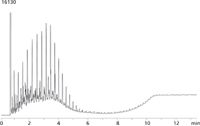Enhanced Results of Diesel Range Organics Analysis with High-Temperature Gas Enhanced Chromatography
The Application Notebook
Diesel range organic (DRO) compounds have boiling points similar to diesel fuel (C10–C28), ranging from 170–430 ?C. These heavy compounds are amenable to GC-FID analysis; however, important considerations should be taken to ensure reproducible results over repeated injections.
Diesel range organic (DRO) compounds have boiling points similar to diesel fuel (C10–C28), ranging from 170–430 °C. These heavy compounds are amenable to GC-FID analysis; however, important considerations should be taken to ensure reproducible results over repeated injections.
While DRO analytical methods may not reach excessively high temperatures, periodic elevated oven ramps should be used to condition the column and remove contaminants. Without a rugged, high-temperature column, the oven ramp may not sufficiently remove contaminants, resulting in decreased reproducibility over repeated injections. To decrease run times, chemists may apply aggressive oven ramps that approach typical columns' temperature limits. Repeated use of a column near its temperature limit can negatively impact its lifetime. For these reasons, high-temperature GC columns are desired for this application. Zebron™ Inferno™ GC columns have the highest temperature limits of any non-metal GC columns (up to 430 °C), and therefore provide the flexibility to increase throughput with aggressive oven ramps, extend column lifetime with rugged temperature stability, and improve reproducibility by baking off contaminants at higher temperatures. This study presents a 10-min method for analyzing DROs using a Zebron ZB-5HT Inferno GC column.
Experimental Conditions
An Agilent 6890 GC/FID was used. Conditions are shown in Table I.

Table I: Operating conditions for DRO methods
Results
The resultant chromatogram for this diesel analysis is shown in Figure 1. The on-column injection technique reduced inlet discrimination and increased sensitivity of late-eluting compounds. To further improve sensitivity, a large-volume injection could be employed. To view a 20 µL injection method, visit www.phenomenex.com and search for Application 18153.

Figure 1: Diesel fuel on ZB-5HT. Sample was 0.1 mg/mL in dichloromethane.
Conclusions
A robust method was presented for DRO fraction analysis using an on-column injection technique. A large-volume injection is suggested for labs interested in improved sensitivity, reduced volumes of extracted samples, and cost-savings. The use of high-temperature columns allowed safe conditioning at elevated temperatures for increased reproducibility and column lifetime.
Phenomenex, Inc.
411 Madrid Avenue, Torrance, CA 90501
Tel. (310) 212-0555, (310) 328-7768
Website: www.phenomenex.com

Separation of Ultra-Short and Long Chain PFAS Compounds Using a Positive Charge Surface Column
December 11th 2024A separation of ultra-short and long chain PFAS (C1-C18) is performed on a HALO®PCS Phenyl-Hexyl column along with a HALO®PFAS Delay column which demonstrates excellent retention for both hydrophilic and hydrophobic analytes.















